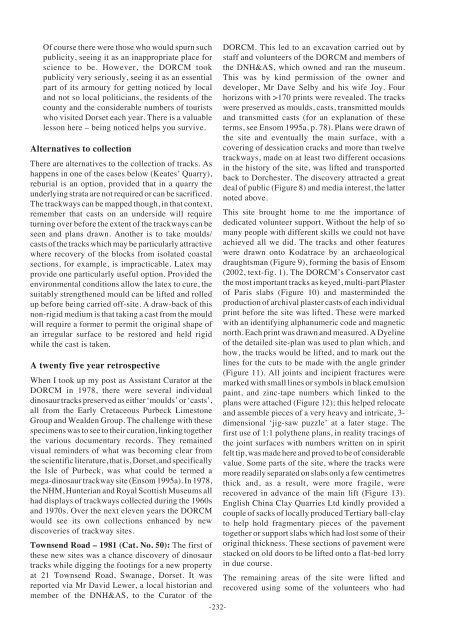Continental trace fossils and museum exhibits - Geological Curators ...
Continental trace fossils and museum exhibits - Geological Curators ...
Continental trace fossils and museum exhibits - Geological Curators ...
You also want an ePaper? Increase the reach of your titles
YUMPU automatically turns print PDFs into web optimized ePapers that Google loves.
Of course there were those who would spurn suchpublicity, seeing it as an inappropriate place forscience to be. However, the DORCM tookpublicity very seriously, seeing it as an essentialpart of its armoury for getting noticed by local<strong>and</strong> not so local politicians, the residents of thecounty <strong>and</strong> the considerable numbers of touristswho visited Dorset each year. There is a valuablelesson here – being noticed helps you survive.Alternatives to collectionThere are alternatives to the collection of tracks. Ashappens in one of the cases below (Keates’ Quarry),reburial is an option, provided that in a quarry theunderlying strata are not required or can be sacrificed.The trackways can be mapped though, in that context,remember that casts on an underside will requireturning over before the extent of the trackways can beseen <strong>and</strong> plans drawn. Another is to take moulds/casts of the tracks which may be particularly attractivewhere recovery of the blocks from isolated coastalsections, for example, is impracticable. Latex mayprovide one particularly useful option. Provided theenvironmental conditions allow the latex to cure, thesuitably strengthened mould can be lifted <strong>and</strong> rolledup before being carried off-site. A draw-back of thisnon-rigid medium is that taking a cast from the mouldwill require a former to permit the original shape ofan irregular surface to be restored <strong>and</strong> held rigidwhile the cast is taken.A twenty five year retrospectiveWhen I took up my post as Assistant Curator at theDORCM in 1978, there were several individualdinosaur tracks preserved as either ‘moulds’ or ‘casts’,all from the Early Cretaceous Purbeck LimestoneGroup <strong>and</strong> Wealden Group. The challenge with thesespecimens was to see to their curation, linking togetherthe various documentary records. They remainedvisual reminders of what was becoming clear fromthe scientific literature, that is, Dorset, <strong>and</strong> specificallythe Isle of Purbeck, was what could be termed amega-dinosaur trackway site (Ensom 1995a). In 1978,the NHM, Hunterian <strong>and</strong> Royal Scottish Museums allhad displays of trackways collected during the 1960s<strong>and</strong> 1970s. Over the next eleven years the DORCMwould see its own collections enhanced by newdiscoveries of trackway sites.Townsend Road – 1981 (Cat. No. 50): The first ofthese new sites was a chance discovery of dinosaurtracks while digging the footings for a new propertyat 21 Townsend Road, Swanage, Dorset. It wasreported via Mr David Lewer, a local historian <strong>and</strong>member of the DNH&AS, to the Curator of the-232-DORCM. This led to an excavation carried out bystaff <strong>and</strong> volunteers of the DORCM <strong>and</strong> members ofthe DNH&AS, which owned <strong>and</strong> ran the <strong>museum</strong>.This was by kind permission of the owner <strong>and</strong>developer, Mr Dave Selby <strong>and</strong> his wife Joy. Fourhorizons with >170 prints were revealed. The trackswere preserved as moulds, casts, transmitted moulds<strong>and</strong> transmitted casts (for an explanation of theseterms, see Ensom 1995a, p. 78). Plans were drawn ofthe site <strong>and</strong> eventually the main surface, with acovering of dessication cracks <strong>and</strong> more than twelvetrackways, made on at least two different occasionsin the history of the site, was lifted <strong>and</strong> transportedback to Dorchester. The discovery attracted a greatdeal of public (Figure 8) <strong>and</strong> media interest, the latternoted above.This site brought home to me the importance ofdedicated volunteer support. Without the help of somany people with different skills we could not haveachieved all we did. The tracks <strong>and</strong> other featureswere drawn onto Koda<strong>trace</strong> by an archaeologicaldraughtsman (Figure 9), forming the basis of Ensom(2002, text-fig. 1). The DORCM’s Conservator castthe most important tracks as keyed, multi-part Plasterof Paris slabs (Figure 10) <strong>and</strong> masterminded theproduction of archival plaster casts of each individualprint before the site was lifted. These were markedwith an identifying alphanumeric code <strong>and</strong> magneticnorth. Each print was drawn <strong>and</strong> measured. A Dyelineof the detailed site-plan was used to plan which, <strong>and</strong>how, the tracks would be lifted, <strong>and</strong> to mark out thelines for the cuts to be made with the angle grinder(Figure 11). All joints <strong>and</strong> incipient fractures weremarked with small lines or symbols in black emulsionpaint, <strong>and</strong> zinc-tape numbers which linked to theplans were attached (Figure 12); this helped relocate<strong>and</strong> assemble pieces of a very heavy <strong>and</strong> intricate, 3-dimensional ‘jig-saw puzzle’ at a later stage. Thefirst use of 1:1 polythene plans, in reality tracings ofthe joint surfaces with numbers written on in spiritfelt tip, was made here <strong>and</strong> proved to be of considerablevalue. Some parts of the site, where the tracks weremore readily separated on slabs only a few centimetresthick <strong>and</strong>, as a result, were more fragile, wererecovered in advance of the main lift (Figure 13).English China Clay Quarries Ltd kindly provided acouple of sacks of locally produced Tertiary ball-clayto help hold fragmentary pieces of the pavementtogether or support slabs which had lost some of theiroriginal thickness. These sections of pavement werestacked on old doors to be lifted onto a flat-bed lorryin due course.The remaining areas of the site were lifted <strong>and</strong>recovered using some of the volunteers who had
















